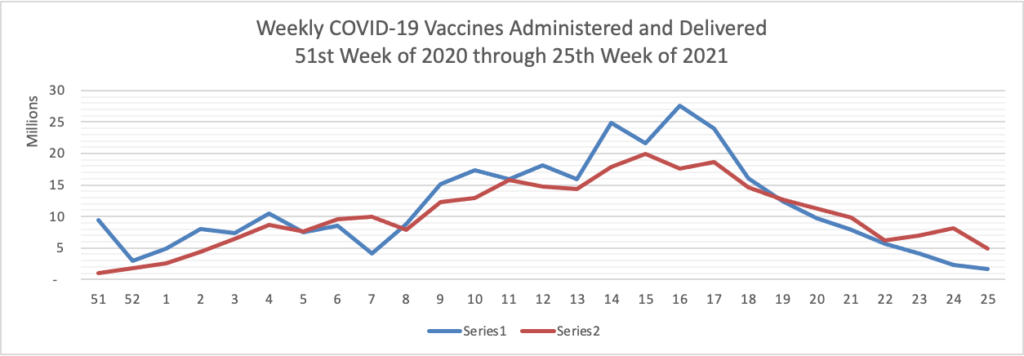Based on the Centers for Disease Control’s COVID-19 Data Tracker website, here is the FEHBlog’s chart of new weekly COVID-19 cases and deaths over the 14th week of 2020 through 25th week of this year (beginning April 2, 2020, and ending June 23, 2021; using Thursday as the first day of the week in order to facilitate this weekly update):

According to the Centers for Disease Control (“CDC”),
| The current 7-day moving average of daily new cases (11,343) decreased 4.4% compared with the previous 7-day moving average (11,867). Compared with the highest peak on January 10, 2021 (252,166), the current 7-day average decreased 95.5%. A total of 33,409,895 COVID-19 cases have been reported as of June 23. |
|---|
Here is the CDC’s latest overall weekly hospitalization rate chart for COVID-19 which also has been steadily decreasing:

The FEHBlog has noticed that the new cases and deaths chart shows a flat line for new weekly deaths because new cases significantly exceed new deaths. Accordingly here is a chart of new COVID-19 deaths over the period (April 2, 2020, through June 23, 2021):

Finally here is a COVID-19 vaccinations chart over the period December 17, 2020, through June 23, 2021, which also uses Thursday as the first day of the week:

As of today, according to the Centers for Disease Control, over 150 million Americans are fully vaccinated. The vaccination campaign has lead to the low levels of new cases and deaths in our country. The Associated Press observes:
Nearly all COVID-19 deaths in the U.S. now are in people who weren’t vaccinated, a staggering demonstration of how effective the shots have been and an indication that deaths per day — now down to under 300 — could be practically zero if everyone eligible got the vaccine.
An Associated Press analysis of available government data from May shows that “breakthrough” infections in fully vaccinated people accounted for fewer than 1,200 of more than 853,000 COVID-19 hospitalizations. That’s about 0.1%.
And only about 150 of the more than 18,000 COVID-19 deaths in May were in fully vaccinated people. That translates to about 0.8%, or five deaths per day on average.
The CDC also reminds us that
Currently, several variants are found around the world, including in the United States. On June 15, 2021, the B.1.617.2 (Delta)* variant was classified as a VOC because it spreads from person to person more easily than other variants and may cause more severe disease. B.1.617.2 has been reported in 77 countries and in the United Kingdom has become the main variant in COVID-19 cases. In the United States, the proportion** of B.1.617.2 for the 2-week period ending June 19, 2021, is predicted to increase to 20.6% nationally and be higher in regions 2, 6, 7, 8, and 9.
The more a virus circulates in a population, the more opportunities it has to transform itself and can reduce the effectiveness of our vaccines. Recent studies have shown that the vaccines available in the United States are effective against variants currently circulating, including B.1.617.2. Vaccines interrupt the ability of the virus that causes COVID-19 to move between people and mutate, so it is important for everyone to get vaccinated as soon as they’re eligible. If you have questions or concerns about vaccines, please contact your healthcare professional, state or local health department, or local pharmacist or visit the CDC website. To find a place in your community to get a vaccine, visit Vaccines.gov or your local public health department website.
In the More department
- The American Managed Care Journal reports that AHIP hosted a small group of U.S. Senators at a recent conference where the Senators offered their thoughts on future federal healthcare legislation.
- Tammy Flanagan in Govexec discusses NARFE’s legislative conference on pending legislation in Congress affecting federal employees, annuitants and their benefit programs, including the Postal Reform Act.
- Healthcare Dive informs us that “The Biden administration’s top health policy official on Thursday [June 24] reiterated his support for expanded telehealth access after the COVID-19 national emergency expires, as Congress considers a slate of bills that would permanently nix regulatory barriers to virtual care. “We are absolutely supportive of efforts to give us the authority to utilize telehealth in greater ways,” HHS Secretary Xavier Becerra said at a virtual event on digital health hosted by The Washington Post. Becerra also stressed that, though affordable telehealth should be available to all, HHS would be doubling down in making sure there’s accountability for quality of care. “We’re going to be doing a lot of bird-dogging, a lot of oversight,” he said.”
- Fierce Healthcare reports on the winners of the IBM XPrize competition to create artificial intelligence tools to tackle global problems. For example, “An Israeli startup that uses artificial intelligence and other tech tools to wipe out malaria took the top prize in IBM Watson’s AI competition, nabbing $3 million to expand its operations. ZzappMalaria, a subsidiary of Sight Diagnostics, developed an AI-powered mobile app and dashboard to tackle malaria on the eradication level, specifically in developing countries.” Very 21st Century.
